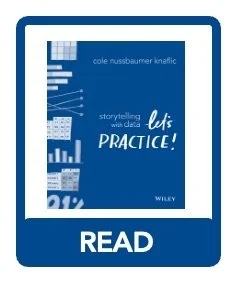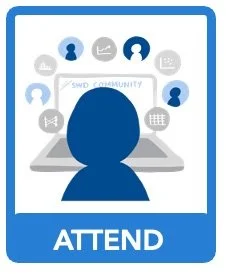WEEK 2: graphs!
STEP 1 | Begin your week by joining us for our live lecture
There are a lot of different types of graphs out there—this week, we’re going to explore visuals during our lecture on Monday, January 20 at 11AM ET. We’ll focus mainly on the ones you’ll likely use most in a business setting when communicating data but also offer avenues to learn about those of the less common variety.
You can watch the graphs lecture recording below:
STEP 2 | Review learning materials
choose a format that will help you learn best–select at least one from the section belowWATCH | graphing data
viewing time 55:46
This is one of our favorite recent videos! Cole reviews a spectrum of graphs—including those we use most often at storytelling with data, those we don’t utilize often but are asked about frequently, and even some xenographs. Not sure what those are? Watch this episode!
READ | storytelling with data: Let’s Practice! chapter 2
choose an effective visual (pages 51-63)
Review a basic overview of common graphs for communicating data in a business setting and then practice with a couple of exercises that allow you to consider various views for a given set of data.
LISTEN | SWD podcast episode 17: which graph should I use?
listening time 39:46
Cole reviews the most common types of data visualizations used in a business setting and discusses use cases and considerations with each.
STEP 3 | Submit the weekly synthesize activity
required for certificate of completionSYNTHESIZE | apply this week’s learnings to your course project
Consider some data that you hope to visualize for your final course project and use learnings from this week to make a great graph: complete the draw it, then iterate in your tool exercise.
STEP 4 | Explore optional resources to support your learning
OFFICE HOURS
We’ll have two sessions of office hours this week. These are optional sessions that you can join to ask questions or chat. Alternatively, if you aren’t able to attend a session this week you can submit a question here.
Meet with Simon on Thursday, January 23 at 4AM ET: register to attend
Meet with Amy on Friday, January 24 at 1PM ET: register to attend
Additional recommended resources
following lecture dive deeper into topics of your choosing
LISTEN | SWD podcast episode 10: right place, right graph
listening time 32:58 (transcript)
Cole discusses graphing for exploration and graphing for explanation, sharing considerations and resources for each. Is there such a thing as a “right” graph? Tune in to find out.
READ | different graphs enable different things
Data can be visualized many different ways, creating an often daunting task to select the best chart to use. This article walks through an example of creating different views of the same data to help decide which version(s) to share.
PRACTICE | which graph would you choose this time?
Different graphs help us see different things, and in this exercise, you’ll get to experience that firsthand. Once you complete this exercise and upload your solution, you will gain access to see others that have been shared previously by the community—and the SWD team—to continue learning by comparing and contrasting approaches.
READ | SWD chart guide
Browse the various charts in our guide and explore by clicking to read detailed posts (specific suggestion: check out the dot plot that gets less coverage elsewhere). You need not read every post now, but this is a good resource to be aware of for when the occasion arises.
WATCH | transform a table
viewing time 21:38
The Elizabeth transform a table into various graphs, while evaluating how the each of the views show the data in a different way. This process of looking at data multiple ways can help us better understand our data and how to communicate it to others.
Awesome work! You’ve built a strong foundation of knowledge about different graph types for communicating with data. Which graph is right for your given situation? It depends. Often, it is by iterating through different views that we can learn what might work best to help get our information across.
Next week… We’ll step back from the data and explore the underlying context: who exactly is our audience, and what do we need them to know or do? How can we craft a message to get this across clearly? How might data fit in? We’ll answer these questions and more as we continue on our data storytelling journey. See you then!


